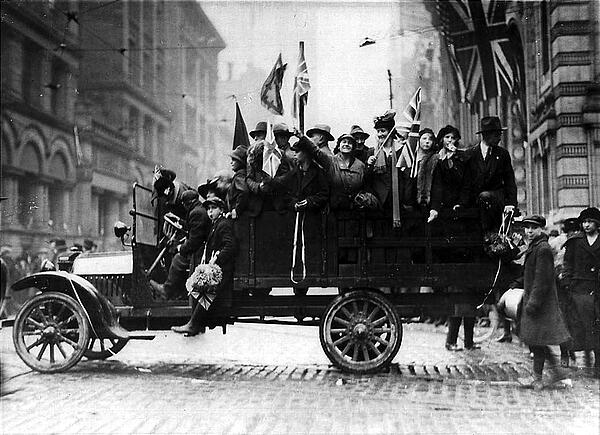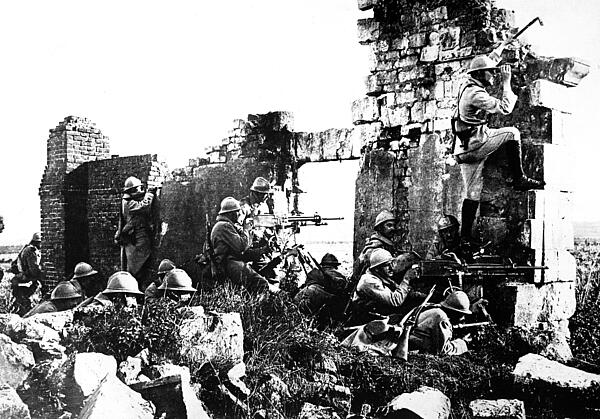1918 and World War One
The year 1918 marked the end of World War One, but not before two major offensives took place on the Western Front. Each of these actions was based on movement rather than the trench mentality of the previous years, thanks in part to the appointment of French Commander Ferdinand Foch as Supreme Allied Commander.
One of the most important moments was the beginning of the Battle of Amiens, which marked the opening phase of the Hundred Days Offensive that ultimately led to the end of World War One. Between the beginning of October and the beginning of November, Germany, Turkey and Austro-Hungary all requested an armistice from the Allies. This was followed by the abdication of Kaiser Wilhelm II on 9 November and, on the 11th hour of the 11th day of the 11th month, the German armistice was finally signed and the war declared to be over.
14 January: Great Yarmouth bombarded by the German Navy.
24 January: Russia rejected Lenin’s peace at all costs for Trotsky’s “no war, no peace.”
1 February: Mutiny in the Austrian Navy at Cattaro.
18 February: Germany resumed her war against Russia after the failure to secure a peace settlement.
24 February: Russia accepted Germany’s peace terms.
3 March: Treaty of Brest-Litovsk was signed between Germany and Russia.
21 March: Germany broke through in the Somme at the start of its ‘Spring Offensive’. 65 divisions attacked along a 60-mile front. The German Air Service launched a major campaign against the Royal Flying Corps but it failed.
26 March: French Marshall Ferdinand Foch is appointed Supreme Allied Commander on the Western Front.
1 April: The Royal Flying Corps and the Royal Naval Air Service are merged to become the Royal Air Force.
9 April: Germany launches its second offensive, the Battle of Lys, which sees Portuguese troops overwhelmed by the German forces.
23 April: The Zeebrugge Raid sees the British Royal Navy attempt to block the Belgian port of Bruges-Zeebrugge, which has become an important German U-boat base.
25 May: German U-boats make their first appearance in US waters.
27 May: The start of the Third Battle of the Aisne, marking the Third German Spring Offensive, begins.
28 May: US troops secure victory in their first major action of the war at the Battle of Cantigny.
15 July: Germany begins the final phase of her spring push, the Second Battle of Marne.
16 July: Former Russian Tsar Nicholas II, along with his wife and children, is murdered by the Bolsheviks.
18 July: The Allies counterattack and seize the upper hand on the Western Front.
8 August: The start of the Battle of Amiens, the opening phase of the Hundred Days Offensive.
15 September: The start of an allied offensive against Bulgaria. Bulgaria signed an armistice less than two weeks later and Bulgaria's King Ferdinand also abdicated.
19 September: The British offensive begins against Turkish forces in Palestine.
26 September: The Meuse-Argonne offensive begins, marking the last Franco-American campaign of the war.
4 October: Germany requests Armistice.
21 October: Germany ceases its policy of unrestricted submarine warfare.
30 October: Germany Navy sailors mutiny. Turkey requests an armistice.
3 November: Austro-Hungary concludes an armistice with the Allies.
7 November: Germany begins armistice negotiations with the Allies.
9 November: Kaiser Wilhelm II abdicates.
11 November: At the 11th hour of the 11th day of the 11th month, Germany signs an armistice with the Allies, marking the end of World War One.

23 March: The Germans made major advances using Storm Troops. Paris was hit with long-range artillery. The British 5th Army suffered major losses.
28 March: First signs seen that Germany’s offensive was losing its impetus with the failed attack on Arras.
29 March: Marshal Foch was appointed Allied Commander on the Western Front.
1 April: The Royal Flying Corps and the Royal Navy Air Service combined to form the Royal Air Force (RAF)
4 April: The German Spring Offensive (the ‘Michael Offensive) petered out and the line stabilised.
9 April: Germany started an offensive in Flanders.
21 April: The German fighter ace, Baron Manfred von Richthofen, the ‘Red Baron’, was killed.
23 April: An Allied attack on the harbours of Zeebruge and Ostend (to block their use as bases for U-boats) took place but was only partially successful.
13 May: The RAF formed a specific strategic bombing force.
24 May: A British squadron landed at Murmansk.
30 May: German troops reached the River Marne.
3 June: American forces at Chateau Thierry helped to end the German advance.
6 June: American troops counter-attacked German forces at Belleau Wood.

25 June: Last German troops forced out of Belleau Wood by the Americans.
9 July: Flying ace James McCudden killed in a flying accident.
15 July: Last major German offensive of the war when 52 divisions attacked in the Marne-Reims Offensive.
31 July: British forces took Archangelsk in northern Russia.
15 July: Second Battle of the Marne started, which saw the collapse of the German army on the Western Front.
26 July: Flying ace Edward ‘Mick’ Mannock was killed in action.
1 August: French forces occupied Soissons.
3 August: Germany completed her withdrawal from the Marne salient.
8 August: The Allies continued their advance against the Germans. The RAF dropped 1,563 bombs and fired 122,150 rounds of ammunition in support of ground forces. This day is known as the “Black Day of the German Army”.
18 August: A British offensive in Flanders began. A French offensive captured Aisne Heights.
21 August: The British renewed their offensive on the Somme.
22 August: British forces captured Albert.
28 August: Canadian troops broke through the Hindenburg Line.
29 August: New Zealand troops occupied Baupanne.
2 September: Australian forces occupied Péronne. Canadian troops continued their advance past the Hindenburg Line.
12 September: 1,476 Allied aircraft supported an US attack at St. Mihiel.
16 September: US forces occupy St. Mihiel.
19 September: Turkish forces collapsed at Megiddo.
26 September: French and American forces started an offensive against German positions at Argonne.
27 September: New British offensive started.
28 September: Fourth Battle of Ypres started.
29 September: Luderndorff asked for an immediate armistice.
1 October: Damascus taken by Australian and Arab forces.
4 October: Germany asked the Allies for an armistice based on Woodrow Wilson’s ‘Fourteen Points’.
9 October: British troops advanced to the last line of trenches in the Hindenburg Line.
13 October: French troops occupied Laon.
14 October: German troops started to abandon the Belgian coastline.
17 October: British troops occupied Lille. Belgian troops reoccupied Ostend.
19 October: Zeebruge occupied by the British.
24 October: Start of the Battle of Vittorio Veneto.
26 October: Luderndorff dismissed by Wilhelm II.
29 October: The German Army experienced mutinies in certain sectors.
30 October: Turkey made peace with the Allies. The Italians captured Vittorio Veneto.
1 November: A major French-US offensive started in the Aisne-Meuse sector.
3 November: Austria-Hungary signed an armistice with Italy. A mutiny occurred within the High Seas Fleet based at Kiel – generally seen as the spark that caused the German Revolution.
4 November: The poet Wilfred Owen was killed. Start of the final Allied offensive on the Western Front.
5 November: General retreat of German forces along the Meuse started.
8 November: German representatives arrived at Compiègne and are handed the terms of an armistice.
9 November: Wilhelm II of Germany abdicated. Belgian forces occupied Ghent.
10 November: Wilhelm II crossed into the Netherlands after it became clear that the German Army and Navy no longer supported him.
11 November: Germany signed an armistice with the Allies, which came into force at 11.00. World War One ended.
MLA Citation/Reference
"1918 and World War One". HistoryLearning.com. 2026. Web.
